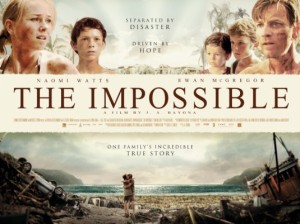The Impossible is probably the most appropriate and well-suited title for a movie I’ve ever heard of. It is based on the true story of a Spanish family’s survival of the 2004 Indian Ocean tsunami. Naomi Watts and Ewan McGregor play the real-life María and Enrique Belón, and three talented child actors, including Tom Holland from Billy Madison, play their sons ages 10, 7, and 5. Watts’ performance was truly breathtaking, and it is because of hers and Holland’s that I suggest going to see this film. At the Palm Springs Film Festival about a week ago, Watts talked about how challenging the film was to make. There was surprisingly a very little amount of CGI (computer generated imagery), and the actors were put into the second-largest indoor tank in the world to recreate the underwater scenes. Watts explained how these scenes were not only incredibly physically demanding, what with powerful jets of water and actual debris being thrown at them, but also emotionally challenging. In the interview Watts said that there couldn’t be too many takes because they actually couldn’t breathe. She said that when she felt she couldn’t go on, she reminded herself of the fact that she was experiencing the discomfort in a safe setting, where she knew she’d be okay, while the actual victims did not.
The one major problem that I have with the film is this: the film takes place in Thailand where about 8,000 people died due to the tsunami, but nowhere in the film was there any explicit statement saying something along the lines of, “in memoriam of the people who lost their lives in the tsunami”. I believe there was a number at the beginning of the film stating how many people are thought to have died, but it seemed to be serving the purpose of explaining how “impossible” the story is. A family of 5 got swept away by the wave, separated, and not only survived, but somehow managed to find one another -no further explanation of how impossible that is is necessary. The story is truly incredible, but I think the decisions that were made in order to prioritize the experience of the family and meet consumers’ expectations, might have sacrificed the aspects that would have made this film truly great. Again, they were in Thailand, but in the film there was no Thai spoken, no subtitles, and what was most stark, was the lack of emphasis on the faces of non-white victims. The editing and storyline clearly prioritized focusing the camera on the white tourists that were in hospital beds, or searching for their lost loves. Not to mention they cast a white blonde-hair, blue-eyed english-speaking family, when the real family was in fact Spanish, and dark-haired. This sort of thing is, of course for the sake of appealing to a wide audience, but I don’t think that their experience would have been like that. Much of the film is from the perspective of the oldest son Lucas, and as a kid, yes he would have been taking everything in, but I think he would have seen a lot more Asian faces and heard a lot of different languages being spoken amidst all the chaos.
The movie was produced by a Spanish company and had a Spanish director etc., but you would never really know that just by watching the film. When the camera showed a truck full of orphaned children being transported to who-knows-where, it was not in as sympathetic of a manner as when the camera showed the two youngest Bennett children; no emotional music swelled for them. It almost suggested, “they’ll be alright because this is their home.” The obvious mistake in that logic is that if you survived the tsunami and were a foreign tourist, you could go home to a home and city that hadn’t been swept away by a wave, unlike the people in the affected regions of East Asia. I can’t say I’ve ever been unsettled by a lack of visible diversity in a movie before. It’s always something that you just expect, and so you don’t question it or barely notice. I can only think that they made the editing choices they did to appeal to a wide audience, and therefore, to make more money. I guess it just disturbed me a bit because it felt like they were trying to profit off of a terrible world event. I don’t actually believe that this feeling is completely accurate, I’m just saying that’s what it felt like the undertone of the visuals were communicating.
It is fascinating how movies create visual codes that either cohere or challenge our understandings of the world. Visually this film is beautiful; the images are so perfectly lit and shot that you feel like you are there with the characters every step of the way of their impossible journey, which considering the subject matter of the film, is rather traumatizing. Traumatizing in neither a good nor bad way; there were some scenes that were so well shot, I’m sure they will be forever imprinted on my mind. This movie is incredible and even though I question some of the decisions that went into making it, it is probably for the best that more people (meaning especially blessed people who have the time and means to see it) do see it, and are reminded of that disaster so that they can get a new appreciation for its victims and survivors. Most importantly, we are once again reminded that the world is big and small at the same time, and we must show compassion towards all people.
